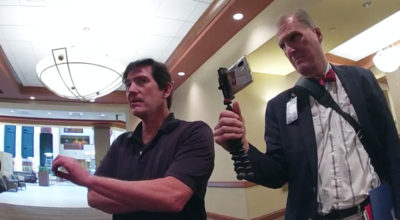
A federal appellate court is upholding a decision to strip a Knoxville Police Department officer of immunity in a wrongful death lawsuit over the officer’s shooting of an unarmed man in the back.
By Jamie Satterfield / Tennessee Lookout
The 6th Circuit U.S. Court of Appeals turned aside an appeal by KPD Officer Dylan Williams, who fatally shot an unarmed Channara Tom “Philly” Pheap in August 2019 in the parking lot of an apartment complex on Merchant Drive in Knoxville.
Williams insisted Pheap, 33, had the officer’s own taser in his hand and was facing him when Williams fired two shots at him. But an autopsy showed Pheap was shot in the back on his left side, and witnesses said they saw Pheap running away when the two gunshots sounded. Pheap’s body was found 40 feet away from the officer at the time the shots were fired.
The U.S. Supreme Court has long held that it is a violation of the nation’s constitution for an officer to shoot an unarmed person who is running away and does not pose a threat. Law enforcers are trained to know that, so they cannot shield themselves from financial liability through the legal doctrine of immunity.
U.S. District Judge Clifton Corker ruled there was plenty of evidence Pheap was shot as he was running away and posed no “reasonable” threat to Williams. He stripped Williams of immunity in a lawsuit filed by Pheap’s sister, Sophia Pheap. The officer appealed.
In a ruling made public late last month, the 6th Circuit agreed with Corker, edging the case toward a jury trial in U.S. District Court.
“The sequence of events immediately before the shooting is crucial to the question of whether Williams’s use of force was reasonable,” the opinion stated.
Off-camera shooting
Williams went to the Clear Springs Apartments complex to follow up on a lead in a hit-and-run investigation. He encountered Pheap as Pheap was walking down a set of stairs from an apartment.
When Williams tried to search Pheap’s pockets, Pheap tried to run and the pair wound up grappling with each other as they rolled down a hill, the litigation shows.
“Williams claims that Pheap was on top of Williams and exerted significant force on Williams’s neck, making it difficult for him to breathe,” the 6th Circuit opinion stated. “Pheap then got up and ran away from Williams into the parking lot, leaving the view of the dash camera.”
Williams gave chase. Once the officer was outside the view of his camera, he drew his taser and ordered Pheap to stop. Pheap did.
“Pheap stopped, put his hands up, and turned to face Williams,” the opinion stated. “Williams approached Pheap and issued multiple commands to get on the ground.”
What happened next was not caught on camera, and it holds the legal key to the case against Williams.
Wound to the back
Williams contends Pheap “lunged at him and grabbed the taser,” the opinion stated. The officer says Pheap pointed the taser at him and fired.
“In response and in an attempt to prevent a second taser attack, Williams drew his firearm and fired two shots at Pheap from approximately six or seven feet away,” the opinion stated.
“Williams claims that at the time he shot Pheap, Pheap was facing him and holding the taser,” the document continued. “(Pheap’s sister), however, disputes Williams’s version of events.”
An autopsy by Assistant Knox County Medical Examiner Dr. Christopher Lochmuller showed Pheap was struck in the upper back on his left side. Lochmuller said the wound’s location supports three possible scenarios:
- Pheap turned away from Williams just as the officer fired.
- Pheap was running from Williams and looked backward as the officer fired.
- Pheap had his left side turned toward Williams when the officer fired.
“The autopsy report found that Pheap died of a gunshot wound to the back,” the 6th Circuit panel wrote. “The medical examiner could not conclusively determine Pheap’s position in relation to Williams when he was shot, and he stated that one of the reasonable interpretations could be that Pheap had his back to Williams and turned to look at Williams as he fired the gun.”
The case has been on hold pending the 6th Circuit’s decision. A trial date has not yet been set in the case.
Jamie Satterfield is an investigative journalist with more than 33 years of experience, specializing in legal affairs, policing, public corruption, environmental crime and civil rights violations. Her journalism has been honored as some of the best in the nation, earning recognition from the Scripps Howard Foundation, the Society of Professional Journalists’ Sigma Delta Chi Awards, the Green Eyeshade Awards, the Tennessee Press Association, the Tennessee Managing Editors Association, the First Amendment Center and many other industry organizations. Her work has led to criminal charges against wrongdoers, changes in state law and citations in legal opinions and journals.


Soooooo, a tased “officer” is able to overcome the electrical tasing and is able to shoot a gun?…
Take notes from the below video and carry the questionnaire (and a Habeas corpus) with you at all times…
https://www.youtube.com/watch?v=fzMi0WHduZI